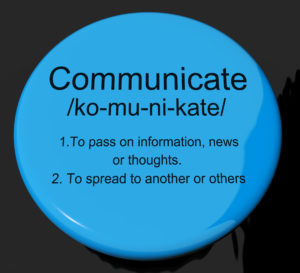My daughter doesn’t know how to communicate.
I’ll never forget that day. It was early on in my career as a teacher and a parent made that comment to me after witnessing another one of my student’s ability to vocalize her discontent because she had to put the toys away. In pursuing that comment with my parent, I learned that beyond the obvious cries for hunger and diaper changes and smiles that indicated contentment and happiness, this parent didn’t see anything else in her daughter’s ability to communicate.
It not only hurt my heart to hear that comment, but it also distressed me to a certain degree. Somehow, I realized, that we as an IEP team, and I as the teacher, was not getting the idea across to my parent of what real communication looks like in our students. I told my parent that day that God created all things to communicate. If plants can communicate thirst by wilting, than your daughter can communicate with more than just tears and smiles.
There are three forms of communication that are very obvious and very familiar to us: verbal and written communication utilizing our words and nonverbal communication that consists of body language, vocalizations, eye contact, gestures, and signs. But, in the world of Special Education, especially with students with severe disabilities, communication takes on a whole new look and a whole new meaning. Often times, their forms of communication are “outside of the box!”
In the world of Special Education, the majority of our students with severe disabilities have limited to no verbal means of communication. But, no verbal means of communication does not mean our students are not communicating to us. Beyond the obvious cries for food and diaper changes, they are. And, most likely, communication has begun long before the tears. The problem is that the majority of us miss these subtle forms of communication all together; and when these nonverbal skills are not reinforced and encouraged, they disappear.
Why do we miss them?
Because we are focused on the obvious: we only see the familiar. The cries to indicate hunger, the smiles to indicate happiness, the temper tantrums to indicate anger, and the pouty lips to indicate hurt feelings. What we miss are those unfamiliar nonverbal means of communication: or what I like to call primitive signs and/or signals. If we catch those signs early and reinforce those signals, we have established a means of communication. We have something to build upon.
What do I mean by primitive?
Primitive means first, developmentally early, very simple in design, natural, and simple in development. It’s a form of communication used for deriving other “words” and the beginning of linguistic (language) development. It is our job to take their simple form of communication and pair the “words” with it, all the while encouraging the student to say the words (or some form of the words) to develop language. This becomes the building blocks for future communicative development.
All of our students exhibit subtle signs and signals before doing something. These signs and signals are not obvious at first, doesn’t mean anything significant at first, and are easy to dismiss. But these signs and signals do mean something to our students. It might look like a simple stare, a grunt, a grimace, before having a bowel movement. It might sound like a smacking of the lips, low hum, or clicking sound to indicate the onset of hunger pangs. Although simple and natural in nature, it is the basis and the beginnings for communication.
What does primitive look like?
My youngest son learned to walk at 9 months of age. By the time he was a little over a year old, he was potty trained and telling me he had to go by saying “pot-pot.” Why? Because I noticed early on that every time he would have a bowel movement, he would first get up from where ever he was at, and run to his room. That became my cue to grab him, sit him on his potty chair, and tell him he is going potty.
I had a student who would briefly pat her diaper area when she soiled her diaper and wanted it changed. At first, it appeared to be random non-purposeful movement because she was limited in her motor movements. But, it soon became clear that the simple signal of “patting” was her way of saying she needed to be changed. Another student would engage in a low humming sound when he was getting hungry, and one of my girls would smack her lips to indicate thirst. I have a student who goes to the table and leans on it to have a bowel movement, while another engages in a “wiggle dance” right before having a bowel movement. In each case, when these simple signs are ignored, they eventually go away.
Our challenge?
To see beyond the obvious nonverbal signs of communication and start looking outside of the box! The signs and signals are there.



